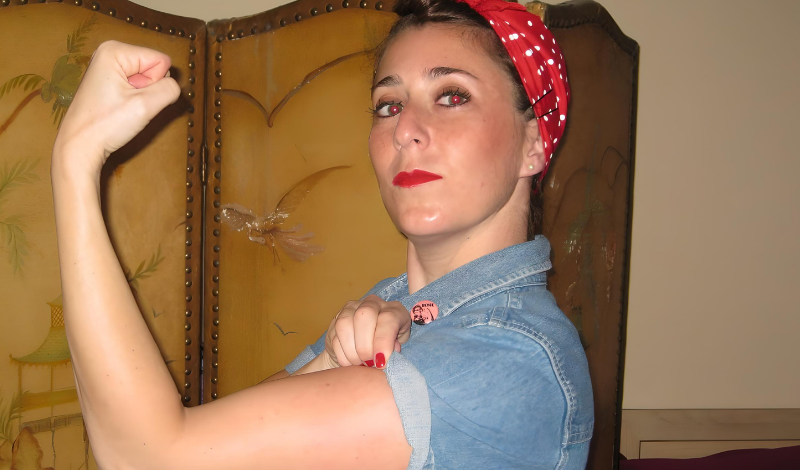
Courtney Silbiger was just 33 years old when she was diagnosed with breast cancer. Following surgery, chemotherapy, and radiation she resumed her busy life as an event and logistics planner for large trade shows across the country. As is normal protocol following a cancer diagnosis, in the ensuing years, Courtney underwent regular screenings and check ups to ensure that her breast cancer had not returned.
Lung Cancer After Radiation Therapy: Advocating for Imaging
For ten years, these tests were normal. In the midst of the Covid-19 shutdowns, Courtney must have had a sixth sense that something was amiss. Due to the pandemic, there had been a lapse in routine imaging. Courtney asked her breast oncologist for a CT scan, just for peace of mind. Her doctor did not think she needed it, but Courtney was persistent in advocating for herself. When her doctor acquiesced in February, 2021, imaging showed a mass in her chest; an incidental finding.
While the medical team initially believed it to be Stage 1 non small cell lung cancer, a lobectomy and the discovery of lymph node involvement changed her staging to 3. Immediately Courtney underwent more chemotherapy. Due to the extensive treatment for her breast cancer, her doctor decided that radiation treatment for lung nodules would not be safe to pursue. Needless to say, these were challenging times.
Radiation Treatment for Lung Nodules Necessary Step
Just ten months later, another incidental finding would derail Courtney’s recovery process. A local recurrence in her chest cavity would put her back in the chemotherapy chair, this time alongside radiation treatment. Then, just a month later, evidence of disease appeared in both her brain and spine.
Upon initial diagnosis, biomarker testing came back somewhat inconclusive; a weak positive for ALK+. Because Courtney’s cancer was Stage 3, targeted therapy was not an appropriate course of action. When, over the course of the next few months, her lymph nodes and tissues were tested, and her staging elevated to 4, it was decided that, while continuing with chemotherapy and radiation, the team would, as a first line treatment, add targeted therapy to the spots on her brain and spine. Within six weeks of starting this treatment, there was no evidence of disease in Courtney’s brain, spine or lymph nodes.
“I feel better than I have felt in years! Even though I am still a Stage 4 cancer patient, there is no cancer currently in my body and I am no longer in a position to be fighting every day.”
Upon hearing Courtney’s story, one is likely to wonder if her lung cancer diagnosis was related to her breast cancer from years earlier. Could this be a metastasis or is it a new cancer? The team of doctors who have treated her for the past decade spent a lot of time and had many discussions on this very subject. Her doctors agreed she has been cured of breast cancer nearly ten years prior. This a new cancer. Might it, however, have played a part in developing lung cancer after radiation therapy?
Lung Cancer After Radiation Therapy Research Findings
Researchers have long been trying to determine the risk of lung cancer after radiation therapy. However, this has been a challenge because most of the studies surrounding this were done many years ago when the radiation techniques were old, less sophisticated, and are, in fact, no longer used. That being said, there are a few studies that have reported an elevated chance of lung cancer with the newer radiation therapy techniques in use today.
A study of several thousand women from 1992 to 2012 found that those who had breast cancer and got radiation therapy were more likely to get lung cancer 20 years later than women who didn’t have breast cancer. In real numbers, the risk was small — 3% of women who had radiation therapy got lung cancer, compared to 2% of women who didn’t have breast cancer. It is not entirely clear what role this played in Courtney’s lung cancer diagnosis following radiation therapy.
It is important to note that fear of a possible lung cancer diagnosis following radiation therapy does not translate to not aggressively treating cancer you have now. For many people with cancer, the benefits of radiation far outweigh the risks. In Courtney’s case, in fact, in part due to her radiation therapy, she was cancer free for a decade. Always talk with your treatment team regarding the pros and cons of radiation therapy and determine together how it will help you, and what side effects it might cause – both now and in the future.
Courtney considers herself lucky. Not just one, but two incidental findings, both of which likely saved her life. She is committed to doing her part to push for greater access to early detection, particularly in younger adults.
Lung Cancer After Radiation Therapy – Courtney’s Perspective
“This experience has changed my perspective on life. I was a stressed out workaholic, always worrying about something. I never stopped. Since my stage 4 diagnosis, I had to let that go. I have jumped out of an airplane, attended Burning Man, gotten a cat – Jillybean – and embraced my love of dressing up and costume parties. Five minute Halloween party, anyone?”
Being diagnosed with lung cancer after radiation therapy for breast cancer was a gut punch for Courtney – especially during the height of COVID restrictions. But, finding an effective targeted therapy put her on the road to living with lung cancer as a chronic disease, like diabetes. Despite a few negative side effects, fatigue chief among them, Courtney is living a full and joyful life. She is working less, traveling more, socializing whenever possible, and enjoying her life at the beach in Southern California.

